Plicidentine in the Early Permian parareptile Colobomycter pholeter, and its phylogenetic and functional significance among coeval members of the clade
- PMID: 24804680
- PMCID: PMC4013015
- DOI: 10.1371/journal.pone.0096559
Plicidentine in the Early Permian parareptile Colobomycter pholeter, and its phylogenetic and functional significance among coeval members of the clade
Abstract
Once thought to be an exclusively anamniote characteristic, plicidentine, a pattern of infolding of dentine, is now known to be found in various amniote clades, including Parareptilia. In the absence of detailed analyses of parareptilian dentition, most parareptiles were assumed to lack plicidentine due to the absence of external indicators, such as plications on the tooth base. The clear presence of this dentinal feature in the largest premaxillary and maxillary teeth of Colobomycter pholeter, led us to the present detailed study within the dentition of this unusual parareptile, and those of coeval members of this clade. Our study reveals that there is large variability in the degree of dentine infolding within C. pholeter dentition, as well as within those of closely related parareptiles. This variability ranges from a lack of plications, to very complex anamniote-like plicidentine. Utilizing computed tomography scans in conjunction with histological sections we also demonstrate the utility of computed tomography scans in conducting non-destructive sampling in the identification of plicidentine. Given the variability of plicidentine in this sample of parareptiles, we hypothesize that one function of parareptilian plicidentine is to increase the surface area for attachment tissues, and we suggest that the use of plicidentine as a character in phylogenetic analyses of parareptiles may be misleading.
Conflict of interest statement
Figures

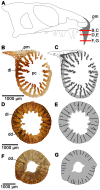
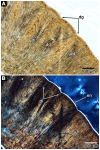
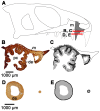

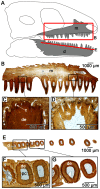


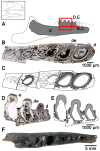
Similar articles
-
Klastomycter conodentatus, gen et sp. nov., a small early Permian parareptile with conical teeth from Richards Spur, Oklahoma.PeerJ. 2024 Nov 19;12:e18393. doi: 10.7717/peerj.18393. eCollection 2024. PeerJ. 2024. PMID: 39583101 Free PMC article.
-
Species richness and disparity of parareptiles across the end-Permian mass extinction.Proc Biol Sci. 2019 Mar 27;286(1899):20182572. doi: 10.1098/rspb.2018.2572. Proc Biol Sci. 2019. PMID: 30890099 Free PMC article.
-
Skeletal anatomy of the early Permian parareptile Delorhynchus with new information provided by neutron tomography.PeerJ. 2023 Aug 22;11:e15935. doi: 10.7717/peerj.15935. eCollection 2023. PeerJ. 2023. PMID: 37637171 Free PMC article.
-
Origin and evolution of gnathostome dentitions: a question of teeth and pharyngeal denticles in placoderms.Biol Rev Camb Philos Soc. 2005 May;80(2):303-45. doi: 10.1017/s1464793104006682. Biol Rev Camb Philos Soc. 2005. PMID: 15921053 Review.
-
Phylogenetic memory of developing mammalian dentition.J Exp Zool B Mol Dev Evol. 2006 May 15;306(3):234-50. doi: 10.1002/jez.b.21093. J Exp Zool B Mol Dev Evol. 2006. PMID: 16463376 Review.
Cited by
-
An intriguing new diapsid reptile with evidence of mandibulo-dental pathology from the early Permian of Oklahoma revealed by neutron tomography.PLoS One. 2022 Nov 30;17(11):e0276772. doi: 10.1371/journal.pone.0276772. eCollection 2022. PLoS One. 2022. PMID: 36449456 Free PMC article.
-
The oldest parareptile and the early diversification of reptiles.Proc Biol Sci. 2015 Feb 22;282(1801):20141912. doi: 10.1098/rspb.2014.1912. Proc Biol Sci. 2015. PMID: 25589601 Free PMC article.
-
A small caseid synapsid, Arisierpeton simplex gen. et sp. nov., from the early Permian of Oklahoma, with a discussion of synapsid diversity at the classic Richards Spur locality.PeerJ. 2019 Apr 11;7:e6615. doi: 10.7717/peerj.6615. eCollection 2019. PeerJ. 2019. PMID: 30997285 Free PMC article.
-
A new recumbirostran 'microsaur' from the lower Permian Bromacker locality, Thuringia, Germany, and its fossorial adaptations.Sci Rep. 2024 Feb 20;14(1):4200. doi: 10.1038/s41598-023-46581-3. Sci Rep. 2024. PMID: 38378723 Free PMC article.
-
First record of plicidentine in Synapsida and patterns of tooth root shape change in Early Permian sphenacodontians.Naturwissenschaften. 2014 Nov;101(11):883-92. doi: 10.1007/s00114-014-1228-5. Epub 2014 Sep 2. Naturwissenschaften. 2014. PMID: 25179435
References
-
- Tsuji LA, Müller J, Reisz RR (2010) Microleter mckinzieorum gen. et sp. nov. from the Lower Permian of Oklahoma: the basalmost parareptile from Laurasia. J Syst Palaeontol 8: 245–255.
-
- MacDougall MJ, Reisz R (2012) A new parareptile (Parareptilia, Lanthanosuchoidea) from the Early Permian of Oklahoma. J Vertebr Paleontol 32: 1018–1026.
-
- Modesto SP, Damiani RJ, Neveling J, Yates AM (2003) A new Triassic owenettid parareptile and the mother of mass extinctions. J Vertebr Paleontol 23: 715–719.
-
- Tsuji LA, Müller J (2009) Assembling the history of the Parareptilia: phylogeny, diversification, and a new definition of the clade. Foss Rec 12: 71–81.
Publication types
MeSH terms
LinkOut - more resources
Full Text Sources
Other Literature Sources

